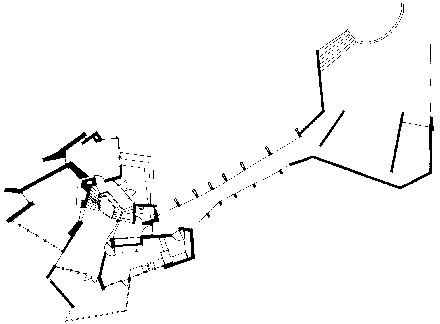
Books and Exhibitions

Twelve Modern Houses
Graham Livesey, Mike McMordie and Geoffrey Simmons, Curators
Reviewed by Ingrid Demeyere & Leo Lejeune
In an attempt at unmasking the identity of the low-profile yet prestigious Canadian Architectural Archives, (a unique collection of original architectural drawings, models and photographs housed here at the University of Calgary's MacKimmie Library), curators Graham Livesey, Mike McMordie and Geoffrey Simmins have assembled a series of Canadian designs for the Twelve Modern Houses Exhibit at the Nickle Arts Museum.
The intention of the Twelve Modern Houses Exhibit is twofold: to emphasize the role of architecture in Canadian culture; and to present various approaches to the incorporation of landscape within residential design solutions.
Upon entry into the exhibition, the visitor is offered a glimpse of the earliest (1945) and latest (1985) projects, suggesting the chronological sequence of the designs within. The material of the twelve houses, is presented in the form of conceptual drawings, construction drawings and photographs. Supporting these are examples of modern furniture and sculpture, as well as a slide presentation.
To those having studied architecture, the material is provocative and is comprehensively assembled. Of special interest are the original sketches produced by the likes of John and Patricia Patkau, Arthur Erickson and Ron Thom. However, despite the intention to demystify architecture for the public, observing the visitors seemed to indicate that the construction drawings were less successful than the conceptual sketches and photographs in achieving this end.
The theme, which explores the relationship between residential architecture and its landscape, is most clearly evident in the comparative series at the end of the exhibition. Here, the floorplan of each of the twelve houses is displayed at the same scale and in the same orientation, allowing the most effective understanding of the evolution of Canadian residential architecture.
A catalogue of the exhibition is published by Aris Press. See article on Aris Press.

Plan from Ron Thom's Fraser House from Twelve Modern Houses

A Practical Guide to Environmental Management on Canadian Campuses
Dixon Thompson & Serena van Bakel
The National Round Table on the Environment and the Economy have published A Practical Guide to Environmental Management on Canadian Campuses by Dixon Thompson and Serena van Bakel.
Universities and colleges in Canada must respond effectively and efficiently to increasing demands to reduce their adverse impacts on the environment, and to bring down the costs of those impacts. This book will help campus decision makers to respond these challenges. It outlines the environmental management tools and systems that can be applied at universities and colleges to tackle environmental challenges in areas such as management and decision-making systems, environmental auditing and assessment, energy, water, solid waste, hazardous materials, and transportation. It is available for free from the National Round Table Office in Ottawa.
Discovering Design: Explorations in Design Studies
Richard Buchanan & Victor Margolin, Editors
Reviewed by Glen Hougan
The eleven essays which make up Discovering Design offers insights into the field and the various forces that shape our material world.
These essays had their start as papers delivered at a conference, Discovering Design, held in Chicago in 1990. Most of the authors are from academic circles representing political theory, philosophy, and design study programmes.
The editors, Richard Buchanen and Victor Margolin, who are also editors of Design Issues, have grouped the essays into three areas: how to shape design as a subject matter, how to distinguish the activity of designing, and how to address the basic questions of value and responsibility in the practice of design. Topics range from; the role of consumers in design decisions to the place of design in social action.
Don't expect this book to be an easy read. Brevity and clarity are not the hallmarks of many of these essays. But if you can get past some of the language there are some interesting insights. Of particular note is Nigel Cross's description of the understanding of the nature of design ability and Victor Margolin's essay "The Product Milieu and Social Action", which describes how everyone participates as a designer.
[ Top of Page | Table of Contents | Intervention | Previous Article | Next Article ]